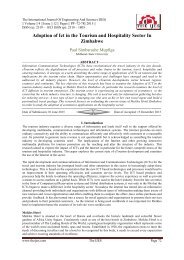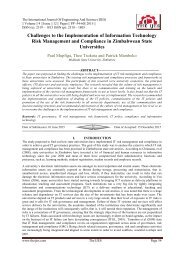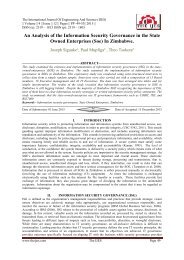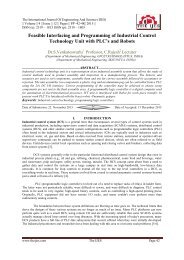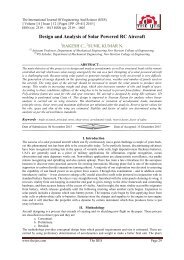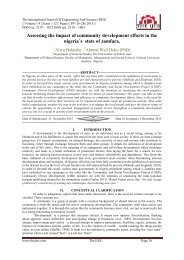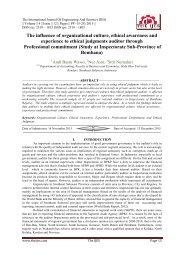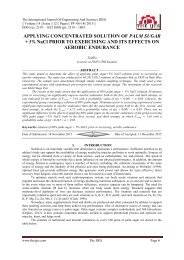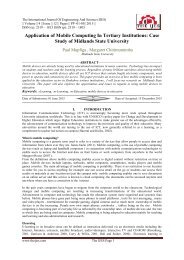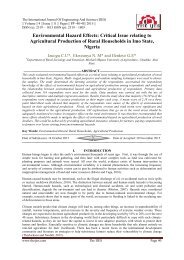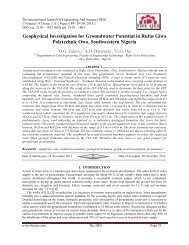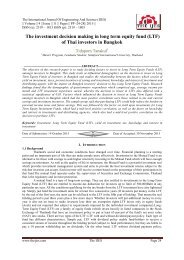On Communicative Competence and Students’ Performance in English Language
You also want an ePaper? Increase the reach of your titles
YUMPU automatically turns print PDFs into web optimized ePapers that Google loves.
The International Journal Of Eng<strong>in</strong>eer<strong>in</strong>g And Science (IJES)<br />
|| Volume || 3 || Issue || 8 || Pages || 65-68 || 2014 ||<br />
ISSN (e): 2319 – 1813 ISSN (p): 2319 – 1805<br />
<strong>On</strong> <strong>Communicative</strong> <strong>Competence</strong> <strong>and</strong> <strong>Students’</strong> <strong>Performance</strong> <strong>in</strong><br />
<strong>English</strong> <strong>Language</strong><br />
1,<br />
Opoola B.T <strong>and</strong> 2, Fatiloro, Oluwayemisi Florence<br />
1, 2,<br />
Department Of General Studies Education<br />
School of Education Federal College of Education (Sp), Oyo<br />
--------------------------------------------------------------ABSTRACT-------------------------------------------------------<br />
Many Nigerian <strong>English</strong> as L2 students particularly <strong>in</strong> secondary schools are still f<strong>in</strong>d<strong>in</strong>g it difficult to effectively<br />
communicate us<strong>in</strong>g <strong>English</strong> as viable medium. Spoken <strong>and</strong> written texts <strong>in</strong> <strong>English</strong> of most students are of no<br />
enviable st<strong>and</strong>ard. The necessary knowledge <strong>in</strong> <strong>English</strong> appears lack<strong>in</strong>g due to absence of sound oral <strong>and</strong> written<br />
drill<strong>in</strong>g <strong>in</strong> <strong>English</strong>. This paper therefore, focuses attention on exposition of students to basic communicative<br />
competence <strong>in</strong> <strong>English</strong> us<strong>in</strong>g comparative <strong>and</strong> pedagogical approaches. The l<strong>in</strong>guistics features of students‟<br />
mother tongues <strong>in</strong> terms of phonetics <strong>and</strong> phonological systems as well as syntactic structures are compared<br />
with those of <strong>English</strong>. Thorough drill<strong>in</strong>g <strong>in</strong> the identical similar <strong>and</strong> different speech sounds of the students‟<br />
mother tongue <strong>and</strong> <strong>English</strong> assisted <strong>in</strong> no small way <strong>in</strong> fortify<strong>in</strong>g the students‟ communicative competency <strong>in</strong><br />
<strong>English</strong>. This paper supports the notion that any competent user of a language should demonstrate accuracy of<br />
the grammatical <strong>and</strong> vocabulary aspects <strong>and</strong> also use such l<strong>in</strong>guistic knowledge appropriately. To achieve this,<br />
the paper recommends among other th<strong>in</strong>gs, communicative approach to teach<strong>in</strong>g of <strong>English</strong> language which<br />
enables learners to underst<strong>and</strong> <strong>and</strong> use utterances rightly <strong>in</strong> different contexts; also that learners should be<br />
exposed to consonant <strong>and</strong> vowel sounds which are absent from their mother tongues (MT) <strong>and</strong> also mentions the<br />
need for the teacher to drill the taught <strong>in</strong> extensive read<strong>in</strong>g.<br />
Key words: communicative competence, performance, <strong>English</strong> <strong>Language</strong><br />
---------------------------------------------------------------------------------------------------------------------------------------<br />
Date of Submission: 07 March 2014 Date of Publication: 10 August 2014<br />
---------------------------------------------------------------------------------------------------------------------------------------<br />
I. INTRODUCTION<br />
Listen<strong>in</strong>g <strong>and</strong> Read<strong>in</strong>g, the receptive skills as well as speak<strong>in</strong>g <strong>and</strong> writ<strong>in</strong>g, the productive skills<br />
possess <strong>in</strong>terlock<strong>in</strong>g relationships <strong>in</strong> their usage. They are all fundamental to competence <strong>and</strong> performance <strong>in</strong><br />
<strong>English</strong> language however communicative competence emphasizes mastery of oral (speak<strong>in</strong>g) <strong>and</strong> written<br />
communications by learners.<br />
<strong>Communicative</strong> competence accord<strong>in</strong>g to Opara (1999) p.5 deals with “performance, that is, the<br />
speaker‟s ability to underst<strong>and</strong> <strong>and</strong> use utterances appropriate to different contexts. It means fluency <strong>in</strong> oral <strong>and</strong><br />
written communication”.<br />
Accord<strong>in</strong>g to Yano (2003), “successful language use for communication presupposes the development<br />
of communicative competence <strong>in</strong> the users of that language which is constra<strong>in</strong>ed by the socio-cultural norms of<br />
the society where the language is used. He further expla<strong>in</strong>ed that Chomsky (1965) made a dist<strong>in</strong>ction between<br />
grammatical competence <strong>and</strong> „performance‟. The former is the l<strong>in</strong>guistic knowledge of the idealized native<br />
speaker, an <strong>in</strong>nate biological function of the m<strong>in</strong>d that allows <strong>in</strong>dividuals to generate the <strong>in</strong>f<strong>in</strong>ite set of<br />
grammatical sentences that constitute their language, <strong>and</strong> the latter is the actual use of language <strong>in</strong> concrete<br />
situation”. This implies that communicative competence denotes demonstration of the grammatical skills.<br />
Pillar (2004) op<strong>in</strong>es that l<strong>in</strong>guistic competence refers to the mastery of knowledge of the language code<br />
itself. This <strong>in</strong>volves controll<strong>in</strong>g the formal organization of the language for produc<strong>in</strong>g or recogniz<strong>in</strong>g correct<br />
sentences <strong>and</strong> organiz<strong>in</strong>g them to form texts. L<strong>in</strong>guistic competence <strong>in</strong>cludes the rules of word formation <strong>and</strong><br />
vocabulary (lexicon), pronunciation (phonology) <strong>and</strong> sentence formation (syntax)”.<br />
<strong>Communicative</strong> competence is s<strong>in</strong>e qua non to students‟ academic success due to the fact that<br />
proficient speak<strong>in</strong>g opens the door of success while writ<strong>in</strong>g tests students‟ l<strong>in</strong>guistic ability. For students to<br />
atta<strong>in</strong> academic peak, mastery of <strong>English</strong> language knowledge is important. Everyday <strong>in</strong>teractions dem<strong>and</strong><br />
demonstration of mastery of l<strong>in</strong>guistics knowledge.<br />
www.theijes.com The IJES Page 65
<strong>On</strong> <strong>Communicative</strong> <strong>Competence</strong> <strong>and</strong> <strong>Students’</strong> <strong>Performance</strong> <strong>in</strong> <strong>English</strong> <strong>Language</strong><br />
Accord<strong>in</strong>g to Okoh (1998) p.9, for academic purposes, speech <strong>and</strong> writ<strong>in</strong>g represent the ma<strong>in</strong> means of<br />
expressive. But while speech deals essentially with sounds <strong>and</strong> hear<strong>in</strong>g, writ<strong>in</strong>g rema<strong>in</strong>s a primarily visual<br />
phenomenon, <strong>in</strong> other words, a system of graphic symbols to be <strong>in</strong>terpreted by the reader, who runs his eyes to<br />
<strong>and</strong> fro the page”.<br />
“Acquir<strong>in</strong>g oral skills <strong>in</strong> an L2 context is no mean task. There are several reasons for this; rang<strong>in</strong>g from<br />
problems with the phonology of the L2, the phenomenon generally referred to as mother tongue <strong>in</strong>terference, to<br />
cultural differences between the different languages or peoples”. (Okoh, 2002) pp.150-151.<br />
Canale <strong>and</strong> Swa<strong>in</strong> (1980) def<strong>in</strong>ed communicative competence <strong>in</strong> the context of second language<br />
teach<strong>in</strong>g. Their view of communicative competence is “a synthesis of knowledge of basic grammatical<br />
pr<strong>in</strong>ciples, knowledge of how language is used <strong>in</strong> social sett<strong>in</strong>gs to perform communicative functions <strong>and</strong><br />
knowledge of how utterances <strong>and</strong> communicative function can be comb<strong>in</strong>ed accord<strong>in</strong>g to the pr<strong>in</strong>ciple of<br />
discourse”.<br />
Oral <strong>and</strong> written communications are key parts of language teach<strong>in</strong>g <strong>and</strong> learn<strong>in</strong>g. It is difficult to<br />
exhibit performance <strong>in</strong> written skills without knowledge of grammar. Grammar aids quick <strong>and</strong> efficient learn<strong>in</strong>g<br />
of a language. Grammar which specializes <strong>in</strong> syntax, morphology, semantics is an essential tool for written<br />
communication. Thus an <strong>English</strong> language student must master grammatical <strong>in</strong>tricacies for accomplishment.<br />
Furthermore communication cannot take place <strong>in</strong> the absence of structures or grammar. To effectively<br />
communicate, knowledge of grammatical forms, lexical, morphological, syntactical <strong>and</strong> phonological features of<br />
<strong>English</strong> language is `crucial. Any competent user of a language should not only demonstrate an accurate use of<br />
the grammatical <strong>and</strong> vocabulary aspects of that language but should be well equipped to use such l<strong>in</strong>guistics<br />
knowledge appropriately.<br />
H<strong>in</strong>drances to <strong>Students’</strong> <strong>Performance</strong> <strong>in</strong> <strong>Communicative</strong> <strong>Competence</strong><br />
Learners of <strong>English</strong> as a second language experience some difficulties <strong>in</strong> the mastery of communicative<br />
competence. This is due to a number of reasons. Opara (1999)pp.2-3, stated that “some phonemes which are present <strong>in</strong><br />
<strong>English</strong> language are absent <strong>in</strong> Nigeria <strong>in</strong>digenous languages. For example, the Igbo language has eight vowel phonemes<br />
/a,e,i,o,u,,u,y,i/ whereas <strong>English</strong> has twelve vowel phonemes, eight diphthongs <strong>and</strong> three triphthongs whereas Igbo has none.<br />
Moreover, <strong>English</strong> vowels have been further divided <strong>in</strong>to long <strong>and</strong> short vowels consequently Igbo speakers of<br />
<strong>English</strong> f<strong>in</strong>d it difficult to dist<strong>in</strong>guish between the pronunciation of words such as sit <strong>and</strong> seat, bad <strong>and</strong> bard; first <strong>and</strong> feast<br />
<strong>and</strong> further pronounce „ch‟ for „S‟. For example, miss becomes mich. Others cannot dist<strong>in</strong>guish between „l‟ <strong>and</strong> „r‟, „t‟ <strong>and</strong><br />
„th‟. The result is that they pronounce „schoor‟ for „school‟ <strong>and</strong> „t<strong>in</strong>k for th<strong>in</strong>k (ti k).<br />
Yoruba users of <strong>English</strong> f<strong>in</strong>d it difficult to pronounce certa<strong>in</strong> <strong>English</strong> sounds like /<br />
z, f / because they are absent from their language. Thus pronounce<br />
th<strong>in</strong>k /t<strong>in</strong>k/ <strong>in</strong>stead of / k/<br />
/zip /sip/ <strong>in</strong>stead of /zip/<br />
/fery / <strong>in</strong>stead of /very/<br />
Moreover, students lag beh<strong>in</strong>d <strong>in</strong> communicative competence because accord<strong>in</strong>g to Roach (1997:3) <strong>in</strong><br />
Soneye (2001)p.75, <strong>English</strong> language has notoriously confus<strong>in</strong>g spell<strong>in</strong>g nature. For example, the follow<strong>in</strong>g<br />
words can pose a problem to learners of <strong>English</strong> as a second language<br />
omission<br />
xylophone<br />
orchestral<br />
juvenile<br />
anecdotal<br />
philanthropist<br />
Okoh (2002) p.162, buttressed this po<strong>in</strong>t that “<strong>English</strong> has quite a number of words which are pronounced<br />
differently from the way they look. Several words even while sound<strong>in</strong>g exactly the same have entirely different mean<strong>in</strong>gs,<br />
while others are spelt <strong>in</strong> terribly odd <strong>and</strong> awkward ways … oral skills hardly st<strong>and</strong> alone; they enter <strong>in</strong>to such other regions<br />
as spell<strong>in</strong>g, writ<strong>in</strong>g, even vocabulary build<strong>in</strong>g”. This implies that teachers should drill students well <strong>in</strong> spell<strong>in</strong>g <strong>in</strong> other to be<br />
able to write words like<br />
owl<br />
altar<br />
alley<br />
thought taught<br />
brais<strong>in</strong>g brazen<br />
shore<br />
feed<br />
hole<br />
cease<br />
awl<br />
alter<br />
ally<br />
shawl<br />
feud<br />
whole<br />
seize etc<br />
www.theijes.com The IJES Page 66
<strong>On</strong> <strong>Communicative</strong> <strong>Competence</strong> <strong>and</strong> <strong>Students’</strong> <strong>Performance</strong> <strong>in</strong> <strong>English</strong> <strong>Language</strong><br />
Barrow (1938) <strong>in</strong> Fatiloro (2005) p.77 said “there is no consistent method of represent<strong>in</strong>g sounds <strong>in</strong><br />
<strong>English</strong>. <strong>English</strong> alphabet does not conta<strong>in</strong> letters enough to represent <strong>English</strong> sounds adequately. The phonetic<br />
representation of <strong>English</strong> sound calls for at least thirty eight different symbols while our alphabets conta<strong>in</strong> only<br />
twenty six letters thus <strong>in</strong> most cases, a letter must st<strong>and</strong> for more than one sound as <strong>in</strong> letter “a” which has<br />
different pronunciations <strong>in</strong><br />
at /æ/ art /a:t/<br />
at /et/ sofa /səufə/<br />
all /ɔ:l/ village /vIlIdz/<br />
Letter c st<strong>and</strong>s for three different sounds as <strong>in</strong><br />
face<br />
/s/<br />
cat<br />
/k/<br />
ocean /sh/<br />
Letter “k” may be represented by k, c, q, ch, ck <strong>and</strong> x as <strong>in</strong><br />
kit<br />
/kit/<br />
cat<br />
/kæt/<br />
quite<br />
/kwaIt/<br />
ache<br />
/eik/<br />
sick<br />
/sik/<br />
A major h<strong>in</strong>drance to second <strong>English</strong> language learners‟ performance is <strong>in</strong>ability to dist<strong>in</strong>guish between<br />
formal <strong>and</strong> <strong>in</strong>formal style of writ<strong>in</strong>gs. Okoh (1998) p.10 op<strong>in</strong>es that “we learn to speak ever before we are <strong>in</strong> a<br />
position to write. <strong>On</strong>e important difference follow<strong>in</strong>g from this then is that while we learn to speak, we have to<br />
be taught to write. In spite of such teach<strong>in</strong>gs some never learn to write fluently <strong>in</strong> an L2….. spoken language<br />
adopts a less formal style while written language ma<strong>in</strong>ta<strong>in</strong>s a more conservative <strong>and</strong> formal posture”. Hence the<br />
students‟ writ<strong>in</strong>gs are full of <strong>in</strong>coherent <strong>and</strong> non-st<strong>and</strong>ard expressions like<br />
I beg you. <strong>in</strong>stead of I plead with you.<br />
How is the body? <strong>in</strong>stead of How is your health?<br />
Please give me pen. <strong>in</strong>stead of Please give me a/the pen.<br />
She is my junior sister. <strong>in</strong>stead of She is my younger sister.<br />
My father is an academician. <strong>in</strong>stead of My father is an academic.<br />
Moreover, students demonstrate lack of mastery of basic grammatical structures which is foundational<br />
to appropriate <strong>and</strong> st<strong>and</strong>ard writ<strong>in</strong>g. Learners of <strong>English</strong> as a second language are fond of committ<strong>in</strong>g errors<br />
rang<strong>in</strong>g from tautological error to misappropriation of words or neologisms, co<strong>in</strong>ages etc. Okoh (1998) p.76<br />
posits that “we cannot achieve an effective style <strong>in</strong> <strong>English</strong> until we have acquired sufficient mastery of the<br />
basic unit for construct<strong>in</strong>g any stylistic edifice namely words”. Thus, a good knowledge of grammatical features<br />
will greatly assist students‟ communicative competence.<br />
Strategies for Effective Teach<strong>in</strong>g <strong>and</strong> Learn<strong>in</strong>g of <strong>Communicative</strong> <strong>Competence</strong><br />
The language experts suggested a number of methods of teach<strong>in</strong>g <strong>English</strong> <strong>Language</strong> rang<strong>in</strong>g from<br />
Grammar-Translation, Audio-L<strong>in</strong>gual to <strong>Communicative</strong> Method. It has been discovered that a major deficiency<br />
of Grammar-Translation method is its focus on development of written skills to the detriment of oral skill.<br />
Audio-l<strong>in</strong>gual method emphasizes drills <strong>and</strong> exercises not rules <strong>and</strong> regulations about grammar.<br />
Williams <strong>in</strong> Opara (1999) p.8 stated the follow<strong>in</strong>g as disadvantages of audio-l<strong>in</strong>gua method:<br />
1. The tendency to focus on discrete items <strong>in</strong> isolated contexts.<br />
2. Mechanical laboratory drills not represent<strong>in</strong>g language as it is used for real-life communication.<br />
3. Overemphasis on aural aspect, to the detriment of those who are visual m<strong>in</strong>ded.<br />
4. An unrealistic <strong>in</strong>stance on error-free learn<strong>in</strong>g<br />
For a result oriented teach<strong>in</strong>g of communicative competence, communicative method should be adapted. This<br />
method assists fluency <strong>in</strong> oral <strong>and</strong> written <strong>English</strong> <strong>and</strong> enables learners to underst<strong>and</strong> <strong>and</strong> use <strong>in</strong>ferences<br />
appropriately <strong>in</strong> different context. Opara (1999) suggests the procedure for communicative method of <strong>English</strong><br />
teach<strong>in</strong>g:<br />
i. Teacher presents the topic <strong>and</strong> facts to be known about it.<br />
ii. He drills the students on the topic.<br />
iii. He presents a model of what is required <strong>in</strong> a communicative exercise or activity <strong>in</strong> pairs or groups.<br />
iv. He allows the students to practice the communicative exercises.<br />
v. The teacher listens to the group <strong>in</strong>teractions tak<strong>in</strong>g note of the language use (ignor<strong>in</strong>g <strong>in</strong>accuracies of grammar,<br />
pronunciation but mak<strong>in</strong>g a po<strong>in</strong>t to deal with them later).<br />
www.theijes.com The IJES Page 67
<strong>On</strong> <strong>Communicative</strong> <strong>Competence</strong> <strong>and</strong> <strong>Students’</strong> <strong>Performance</strong> <strong>in</strong> <strong>English</strong> <strong>Language</strong><br />
vi.<br />
Towards the end of the lesson, the teacher holds a discussion on the appropriateness of language based on his<br />
notes.<br />
Okoh (2002) p.160 stated that “one important aspect of oral skills concerns the need for fluency which can only<br />
come from the habit of do<strong>in</strong>g the language we are learn<strong>in</strong>g … the practic<strong>in</strong>g ESP teacher is likely to structure his oral lessons<br />
to follow the basic pattern of three stages or the three Ps- presentation, practice <strong>and</strong> production. In presentation, the teacher<br />
presents some new materials, <strong>in</strong> practice, the students are made to work under his direction <strong>and</strong> f<strong>in</strong>ally <strong>in</strong> production,<br />
students are allowed to work on their own.<br />
The bil<strong>in</strong>guals must be well versed <strong>in</strong> <strong>English</strong> language phonetic alphabets to avoid mispronunciation. It is<br />
essential to underst<strong>and</strong> that there are too many words <strong>in</strong> <strong>English</strong> that are not produced as they are spelled. E.g.<br />
Total<br />
Straight /streit/<br />
Palm<br />
Wednesday<br />
/Totl/<br />
/pam/<br />
/wenzdi/<br />
Both the teachers <strong>and</strong> students alike must be eye <strong>and</strong> ear-m<strong>in</strong>ded. There is a need for tra<strong>in</strong><strong>in</strong>g to notice what<br />
sounds make the spoken word, irrespective of the letters with which it is spelt. Teachers should engage students <strong>in</strong><br />
dist<strong>in</strong>guish<strong>in</strong>g between different sounds as well as different shades of the same sounds.<br />
There is a correlation between extensive read<strong>in</strong>g <strong>and</strong> perfect writ<strong>in</strong>g. Thus students should be exposed to wide<br />
read<strong>in</strong>g. This will go a long way to boost their vocabulary <strong>and</strong> strengthen mastery of grammatical structures which are<br />
foundational to written communication.<br />
For clarity <strong>in</strong> writ<strong>in</strong>g, teacher should emphasize the need for right choice of words <strong>and</strong> parallelism. Writ<strong>in</strong>g should<br />
be devoid of ambiguous expressions through the use of correct simple sentences <strong>and</strong> choice of identical grammatical<br />
structures (parallelism).<br />
Conclusion <strong>and</strong> Recommendations<br />
<strong>Communicative</strong> competence is an <strong>in</strong>tegral aspect of <strong>English</strong> <strong>Language</strong> classroom. To atta<strong>in</strong> success <strong>in</strong> academic<br />
career, a good grasp of both oral <strong>and</strong> written communication cannot be neglected by students. The paper has been able to<br />
po<strong>in</strong>t out the h<strong>in</strong>drances <strong>and</strong> strategies for its atta<strong>in</strong>ment. It behooves both the teacher <strong>and</strong> the taught to work hard for<br />
practice makes perfect for the overall benefit of all stakeholders <strong>in</strong> <strong>English</strong> language. The paper thus proposes the follow<strong>in</strong>g:<br />
1. That the student should be encouraged to read wide because extensive read<strong>in</strong>g empowers vocabulary development<br />
which is a necessary tool for written communication.<br />
2. Learners of <strong>English</strong> as a second language should be earlier exposed to consonant <strong>and</strong> vowel sounds that are absent<br />
from their mother tongues (MT) to avoid <strong>in</strong>terference phenomenon.<br />
3. Nigerian government should stimulate read<strong>in</strong>g by provid<strong>in</strong>g numerous well equipped public libraries for students<br />
<strong>and</strong> <strong>English</strong> users generally.<br />
4. <strong>Communicative</strong> approach which emphasis not just grammatical knowledge but also oral <strong>and</strong> written skills should<br />
be adopted by <strong>English</strong> teachers <strong>in</strong> L2 classroom.<br />
REFERENCES<br />
[1] Barrow S.T. (1938). An <strong>in</strong>troduction to the phonetic alphabet analysis of the spoken word. Boston, Expression Company .<br />
[2] Chomsky, N. (1965). Aspects of the theory of the syntax. Cambridge, mass press <strong>in</strong> Yano Y. (2003). <strong>Communicative</strong> competence<br />
<strong>and</strong> <strong>English</strong> as an <strong>in</strong>ternational language. Waseda<br />
[3] University <strong>in</strong> www.Google.com Retrieved on 21st February, 2014.<br />
[4] Canale, M. <strong>and</strong> Swa<strong>in</strong> M. (180). Theoretical bases of communicative approaches to second language teach<strong>in</strong>g <strong>and</strong> test<strong>in</strong>g.<br />
Applied l<strong>in</strong>guistic 1/1: 1-47. In Yano Y. (2003) <strong>Communicative</strong> competence <strong>and</strong> <strong>English</strong> as an <strong>in</strong>ternational language.<br />
Waseda University <strong>in</strong> www.Google.com Retrieved on 21st February, 2014.<br />
[5] Fatiloro O.F. (2005). Miscue patterns <strong>in</strong> <strong>English</strong> oral read<strong>in</strong>g of junior secondary school students <strong>in</strong> some schools <strong>in</strong> Ogbomoso,<br />
Oyo State. A dissertation submitted <strong>in</strong> partial fulfillment of requirement for the award of M.ED degree <strong>in</strong> language<br />
education to the Department of Teacher Education, University of Ibadan<br />
[6] Opara S.C. (1999). Applied <strong>English</strong> l<strong>in</strong>guistics. Lagos, T-excel publishers.<br />
[7] Okoh, N. (1998). Writ<strong>in</strong>g right <strong>in</strong> <strong>English</strong>. Akwam Ibom, BELPOT (Nig) co.<br />
[8] Okoh, N. (2002). Effective bus<strong>in</strong>ess communication <strong>in</strong> <strong>English</strong>. Port Harcourt, Lamision<br />
[9] publishers.<br />
[10] Pillar, G.M. (2014). A framework for test<strong>in</strong>g communicative competence. University College of Nyiregyhaza, Hungry.<br />
Gr<strong>and</strong>enpillar Chotma<strong>in</strong>.com. retrieved on 21st February, 2014.<br />
[11] Soneye T. (2001). The <strong>English</strong> language <strong>and</strong> the Nigeria elite: A phonological perceptive <strong>in</strong> Ife studies <strong>in</strong><br />
<strong>English</strong> language volume 5 September 2001<br />
[12] Yano, Y. (2003). <strong>Communicative</strong> competence <strong>and</strong> <strong>English</strong> as an <strong>in</strong>ternational language. Waseda University <strong>in</strong><br />
www.Google.com Retrieved on 21st February, 2014.<br />
www.theijes.com The IJES Page 68



